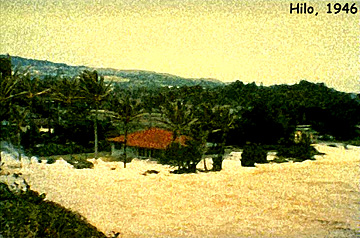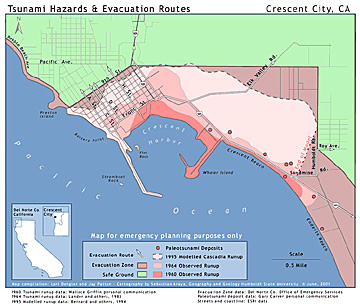
When the ocean swallows Capistrano
That's the day you promised to float back to me
When you whispered, "Farewell", in Capistrano
Twas the day your Chevy floated out to sea
All the mission bells will ring
The chapel choir will sing
Your Naugahyde box spring
Will live in my memory
When the ocean swallows Capistrano
That's the day I pray that you'll float back to me
—When the Swallows Come Back to Capistrano, sort ofEVER SINCE that Indian Ocean disaster two years ago, we’ve been hearing about tsunamis. So I’m sure you’re aware that we on the West Coast are vulnerable to such events. That’s cuz
Shake 'n' Bake + Ocean = Tsunami.
 Tsunami Central in California is Crescent City, about 20 miles south of the Oregon border. According to Wikipedia,
Tsunami Central in California is Crescent City, about 20 miles south of the Oregon border. According to Wikipedia, …the city experienced tsunami conditions 17 times between the years 1943 and 1994. …[T]he city was extensively damaged by a tsunami [bringing over 20-foot waves] in 1964…. There were 12 fatalities…. The city is deemed to be tsunami-ready today. Its preparedness was tested on June 14, 2005 when an earthquake measuring 7.0 on the Richter scale hit 90 miles offshore. Reportedly, much of the city was evacuated in a matter of 20 minutes when a tsunami warning was issued, but no waves were reported.Sounds good. But Wiki goes on to report an event that occurred a little more than a week ago:
On November 15, 2006, a magnitude 8.3 earthquake struck off Kuril Island in the eastern Pacific. A tsunami warning was issued but rescinded hours later. However, a surge from that quake did hit the harbor at Crescent City causing damage to three docks and several boats.This morning, I found an article in Inside the Bay Area/Oakland Tribune that describes a report on recent California tsunami warnings by a San Mateo County Civil Grand Jury. According to the article, the grand jury found that San Mateo County’s coastal cities are unprepared for a “tsunami strike.” In the case of the 2005 tsunami alert, “Many coastal residents didn't learn of the warning until it was canceled, and many of those that did hear the warning found out through the National Weather Service on television. Moreover, no broadcast was made either at the coast's beaches or on the streets.”
Why am I not surprised?

THE TSUNAMI THREAT TO KHAL-EE-FORNIA
I came across a recent (12/05) study by the State of California Seismic Safety Commission entitled The Tsunami Threat to California (a 15-page pdf file). (Among the dozen or so members of the CSSC is seismologist Lucy Jones. You remember her!)
I recommend that you read this highly-readable report. Among its findings:
● Tsunamis, generated either locally or from events elsewhere in the Pacific Basin, pose a significant threat to life and property in California.
● Californians are not adequately educated about tsunamis and the risk they pose….
● The existing tsunami warning system has not achieved all of its objectives for several reasons including problems with communications, agency coordination and protocols.
● Present building codes and guidelines do not adequately address the impacts of tsunamis on structures….
● …[M]ore effort and a better understanding of the risk is required to bring the treatment of tsunamis to a level comparable to other State hazards such as earthquakes.

WHAT ABOUT SOUTHERN CALIFORNIA?
I happened upon a 4-year-old study, funded by FEMA, entitled Evaluation of Tsunami Risk to Southern California Coastal Cities. (It’s a 32 page pdf file.)
This study focuses on the risk caused by very local earthquakes (Catalina Island), though it does briefly note the potential for landslides and “distant” earthquakes.
The article is pretty technical. In its “conclusions” section, it states:
Significant run-up was measured along the southern California coast from Point Mugu to Solana Beach at the ends of the bathymetry grid. Maximum run-up exceeded one meter along most of the coast between Santa Monica and Dana Point, with peaks of 1.5-2.2 m at Marina del Rey, Redondo Beach, Los Angeles and Long Beach harbors, and the Orange County coast from Seal Beach to Newport Beach.I think they’re saying that much of the OC coastline is at risk:
These areas most severely affected also correspond to the major harbor areas where marine terminals and boating facilities are located in harm’s way. Experience from historical distant…show these harbor areas to be vulnerable to strong currents that scour pilings and smash boats…. [A]ctual coastal run-up values from large earthquakes on the Santa Catalina Island restraining bend may exceed 2-4 m. Travel time between the earthquake occurrence and arrival of the first waves at the adjacent coast varies from 10-20 minutes for the areas most severely affected, much shorter for locations on the island, so that no official warnings could be broadcast in sufficient time for evacuation. [The earthquake itself]…may provide the only warning to affected coastal residents, and concurrent quake-related damage, including potential widespread liquefaction and failures of oversteepened coastal bluffs, may exacerbate evacuation or rescue efforts. Fortunately, large earthquakes on this major offshore fault system appear to be infrequent, with estimated recurrence intervals measured in several hundred to thousands of years….If I read the report correctly, it goes on to say that the chance of a major tsunami caused by local earthquakes is not high (because they are historically infrequent), but that the death and destruction caused by such an event would be so great that the only reasonable view is to regard the threat as real and important:
…Consequently, the hazard posed by locally generated tsunami attack is very serious and should be appropriately mitigated. Lastly, this study only examined the tectonic deformation from large earthquakes as potential tsunami source. Large-scale submarine landslides represent a serious threat, and the large earthquakes we have modeled would very likely trigger widespread slope failures, both subaerially along the coasts and submarine landslides along the steep borderland slopes….(My emphases in above quotations.)
(See also: Tsunami Research Center (USC))





